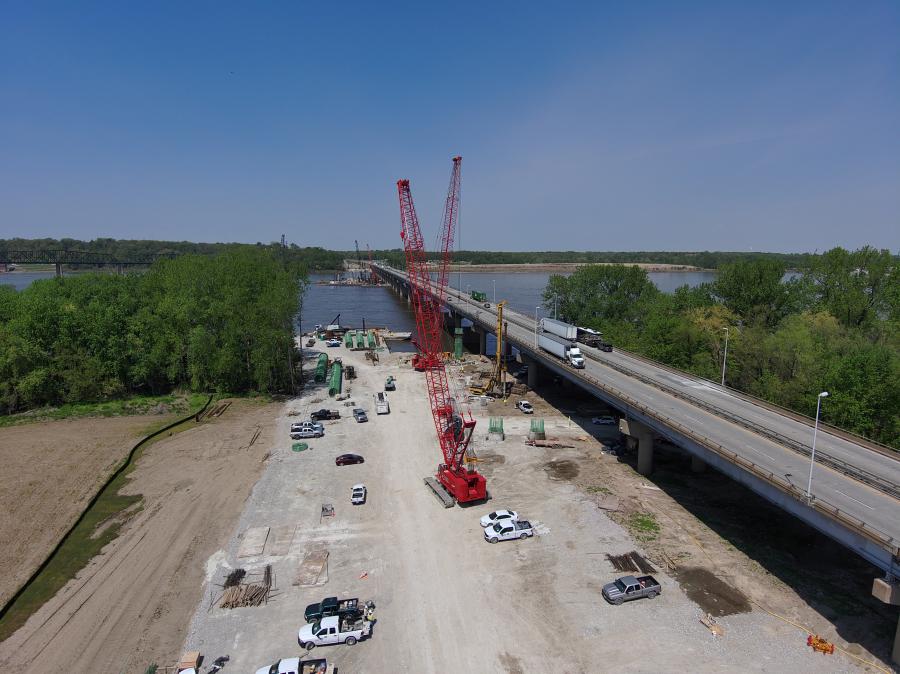IDOT and MoDOT have collaborated on the project since its inception.
(IDOT photo)
Despite limited access both on land and by river, crews are making significant progress on the $532 million I-270 Chain of Rocks Bridge project. The existing structure, which connects Illinois and Missouri, is aging and must be replaced.
"This project represents a great partnership between the Illinois Department of Transportation [IDOT] and Missouri Department of Transportation [MoDOT] to replace a critical roadway crossing the Mississippi River," said Kirk Brown, IDOT Region 5 engineer. "The existing I-270 bridge has reached the end of its service life. The bridge deck has undergone several costly repairs in recent years to keep it in acceptable condition.
"With today's much higher traffic and truck volumes, each repair project adds significant delay costs to our users. Just as important, the replacement bridge provides widened shoulders to accommodate stalled or damaged vehicles, increasing safety for all users."
Although the project will take several years to complete, Brown said the undertaking will be worth the wait.
"The new bridge will be much safer and more reliable for commuters. We think there will be universal appreciation for this modernized structure. With a bridge length exceeding one mile, drivers will appreciate the wider, safer shoulders for stalled vehicles. Safety also will be improved for incident first responders and tow vehicles. Repair projects that interrupt traffic flow should all but cease for the near future, resulting in reliable commute times and allowing repair funding to be directed to other highway system needs."
Brown explained that the prime contractor and subcontractors have been hard at work building the drilled shafts and foundations.
"They've been helped by a mild winter, and so far, have not experienced delays from river levels that are too high or too low, which could potentially flood the work area or impede drilled shaft construction by barge, respectively. By keeping an aggressive schedule while constructing the first bridge, which will carry all four traffic lanes, they decrease the risk of future weather delay impacts."
The existing 5,400-ft.-long Chain of Rocks structure was built in 1966 between St. Louis, Mo., and Madison County, Ill. Composed of 43 spans, the bridge carries four lanes of traffic, with two in each direction. Through the years, numerous repairs have been made to the superstructure.
MoDOT has designed a new diamond interchange for Riverview Drive at I-270, which will be reconstructed to accommodate the IDOT replacement of the Chain of Rocks bridge. IDOT and MoDOT have collaborated on the project since its inception. Both DOTs advertised separate contracts at the same time; however, both contracts were awarded to a single low bidder for the combination of bids between the two contracts. The prime contractor for both projects is Walsh Construction.
Except for occasional short-term off-peak lane closures, the plan is to keep four lanes of traffic open to the public during all stages of construction. The new eastbound structure will be constructed first. Traffic will be shifted to the eastbound structure before removing the existing Chain of Rocks structure. Once the bridge is demolished, construction of the westbound structure will begin. The new westbound structure essentially will be placed on the same alignment as the existing bridge.
"Work on the drilled-shaft foundations for the eastbound bridge continues, and construction has begun on the piers," said Brown. "Earthwork activities have begun to widen the embankments for the eastbound bridge, and other ancillary items are in the works to prepare for the new alignment."
Construction milestones will include completion of the eastbound bridge, demolition of the old bridge and completion of the westbound bridge. Brown noted that while workers have not yet been affected by the weather, they must keep an eye on more than just the local forecast.
"Heavy rains from the Missouri and Mississippi river basins, which also could be impacted by the Illinois River, could potentially cause flooding at this site. Conversely, unreasonably dry conditions farther up the river basins may mean very low water conditions at the site, which would cause problems with being able to float the barges into position to perform the work."
River conditions pose the biggest challenge to the project, because either flooding or extreme drought will delay the schedule. Other scheduling issues with equipment availability and material deliveries may affect the project, which could be further complicated by material shortages and supply chain issues. In addition, the location of the project can make it difficult to transport equipment and materials into and out of the site.
Brown said the project includes approximately 160,000 cu. yds. of excavation but will still require about 27,000 cu. yds. of soil to be brought in from a borrow site to complete the embankments. Various types of cranes will be needed during construction, along with multiple drill rigs, a Wirth pile top drill rig, excavators, off-road trucks, wheel loaders, concrete pumps, barges and tugboats.
Materials include 73,000 sq. yds. of concrete pavement and shoulders; 23,000,000 lbs. of reinforcement bars; 48,000 cu. yds. of concrete in the bridges, 27,000 cu. yds. of drilled-shaft foundations and 31,000,000 lbs. of structural steel.
Construction began in October 2022 and is expected to take roughly four years to complete. CEG
Today's top stories



















